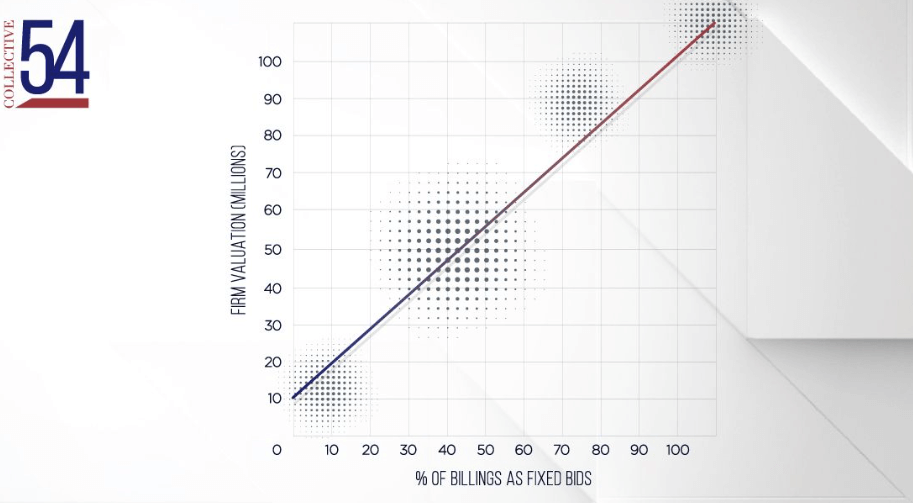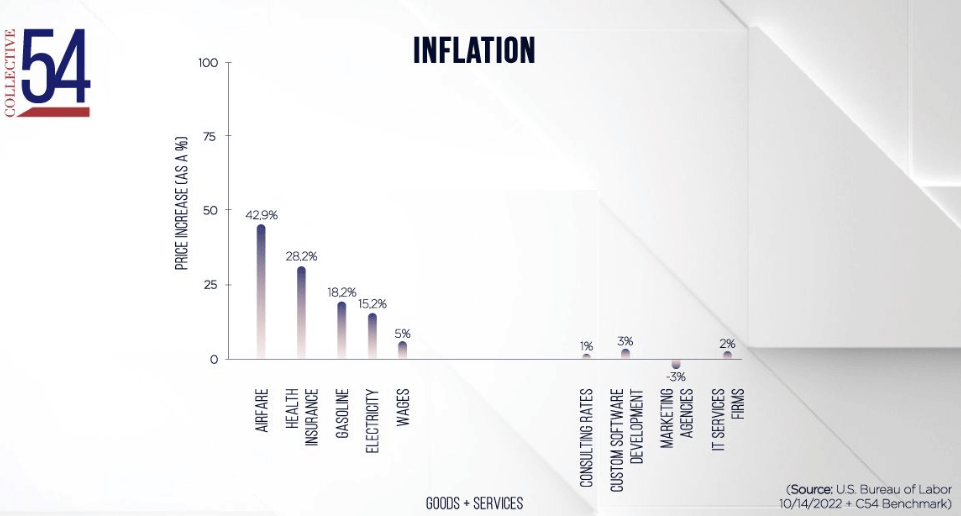Fixed Bid Pricing vs Firm’s Valuation
Fixed Bid Pricing vs Firm’s Valuation

The relationship between a fixed bid pricing strategy and a firm’s valuation. More fixed bids = higher valuation.
Why? Better margins.
Why Changing Your Pricing Strategy is the Quickest Way to Scale
Why Changing Your Pricing Strategy is the Quickest Way to Scale
A change to your pricing strategy is, perhaps, the quickest way to scale. Why? It does not require an investment in people or money to implement. The benefits of revisiting your firm’s pricing are immediate: charge more today than you did yesterday. Are you looking to scale your boutique? Change your pricing strategy first.
Pricing Mistakes Boutique Owners Make When Scaling a Business
One of the biggest challenges for professional services firm owners when scaling a business is choosing the right pricing strategy. Most boutiques price their services incorrectly from the beginning. Here are the main reasons why:
- Boutiques do not know what their services are worth to their clients.
- Boutiques do not know what their clients are willing to pay.
- Boutiques cannot logically explain to clients why they charge what they charge.
- Boutiques cannot quantify the amount of value a client receives from an engagement.
- The pricing approach is inward out – that is, based on internal costs.
- Boutiques focus too heavily on what their competitors charge for similar services.
- Sales teams inside boutiques cannot overcome pricing objectives effectively.
The good news – this problem is simply solved. It takes some sound judgment, but pricing best practices are readily available, and they can make all the difference for owners in developing a scalable plan for their business. Here are a few best practices professional services firm owners should use to get started.
Scaling a Business: How to Create a Pricing Strategy That Aligns With Your Firm
Many entrepreneurs have asked me how they should choose the right pricing strategy. Here’s what I tell them: “Develop a pricing strategy that matches your business strategy.” For example, if you sell to small businesses, the high-volume, low-price model makes sense. The low-volume, high-cost approach is best if you sell luxury items to the elite. If you sell differentiated products to midtier customers, premium pricing makes sense. For instance, a Lexus costs more than a Camry but less than a Rolls Royce.
The key takeaway: connect your pricing strategy to your business strategy. Here are two pricing models to consider when scaling a business.
Price Positioning
Perception is a reality in pricing. Therefore, price positioning is very important. Your firm’s pricing sends a signal to the client. The price influences how a client perceives you. Price too low, and your work will be considered low quality. Price too high, and you will be perceived as difficult to engage. If you price the same as your competitors, you will be perceived as a commodity.
Clients value specific attributes of your service offering. Understand what those are and influence the perception of your performance in these areas. An example from my past might help you appreciate the power of perception.
The structure of the management consulting industry has three tiers. The first tier is the large market leaders. The second tier is the midsize boutiques. The third tier is the small start-ups or one-man shops. My firm, SBI, was a tier-two management consulting firm. A midsize boutique. We priced our services below the first tier but above the second tier. What perception did this send to clients?
It said that we were the best of the boutiques. Clients who wanted to hire a boutique but were afraid to hire us. These clients felt that moving away from a brand-name firm was risky. Yet they were willing to take the chance because hiring us reduced the risk. We were the best of the boutiques and close to the tier-one providers. The perception the price set was that my firm was a premium boutique. This was a powerful differentiator.
Price Versioning
An alternative pricing strategy to use when scaling a business is price versioning. Use price versioning to allow clients to choose their own price. This will result in them deciding on a proposal faster. Giving clients a choice allows the boutique to link price and value. Price is what you pay. Value is what you get. And the two are never the same.
For example, personal trainers sell packages to their clients. The bronze package is $/visit. The silver package is a $/fitness program. The gold package is $/wellness program. The choice allows the client to consider what they value: visits, fitness programs, or a wellness program.
Listen to this episode of the Collective 54 podcast, The Revenue: A Practical Guide to Monetize Professional Services, for more tips on identifying revenue streams and monetizing professional services.
Pricing Questions to Ask When Scaling a Business
Are you wondering whether a new pricing strategy would help you scale? First, you need to understand whether your current pricing is an issue for your clients and business. Ask yourself these questions. If you answer no to most of these questions, you need to revisit your pricing strategy as part of your scalable plan.
- Do you know what your services or products are worth to your clients?
- Can you quantify the value of your work?
- Do you know how much clients are willing to pay for your offerings?
- Can you explain the logic behind your pricing model to clients?
- Does your price demonstrate to the client the link between price and value?
- Do you charge the most for the service features your clients want the most?
- Do you charge the least for the services features your clients don’t care much about?
- Do you allow your clients to choose their price by offering varying price packages?
- Is your sales team skilled at overcoming price objections?
- Have you built an annual price increase into your pricing system?
Looking to Scale Quickly? Change Your Pricing Strategy
Know your worth. Don’t undervalue yourself. What you do is exceptional. Price accordingly. The clients you want know this and will pay you with a smile. You do not want the clients who are unwilling to pay you fairly.
For more insights on how to scale your consulting business, join our mastermind community. Collective 54 is the first mastermind group for professional services firm owners. Contact us today to learn more about the benefits our group offers firms like yours.
#1 Tip to Grow Your Consulting Business: Solve Your Client’s Urgent Problem
#1 Tip to Grow Your Consulting Business: Solve Your Client’s Urgent Problem

To grow your consulting business, it is best to begin with the problem you will solve for clients. Why? There are lots of firms with solutions that no one will buy. The idea you have for your firm is valid, but only if you can do the following:
-
- State the problem you solve for clients.
- Determine that the problem is pervasive.
- Confirm that clients will be willing to pay to solve it.
- Prove that the problem is urgent.
Growing a consulting business is challenging. In the early days of your business, you will be working for free. You will be burning through whatever cash you have until clients start paying you. There will be competing professional services firms you’ll need to defeat to grow. You cannot afford to waste time evangelizing a solution. You need to generate paying clients as quickly as possible. So, how do you do that? Identify your client’s urgent problem.
How to Get More Clients? Identify Your Client’s Urgent Problem
Hypothesizing that your client’s problem is pervasive without backing it up with research and definitive proof is a waste of time when starting a professional services firm. If you fail here, you will struggle to grow your consulting business further down the line.
Your firm’s solution should be addressing a client’s pain point that is urgent and that they are willing to pay for. If your solution is more of a nice-to-have, you will fail to see an increase in your client base. Let’s look at what happens when you don’t adequately research the need for a solution before entering the market.
Case Study: Mistakes to Avoid When Growing Your Consulting Business
An entrepreneur recently came to me looking for investment capital. He had an idea for a professional services firm. He was seeking start-up capital to hire staff, develop the service, and take it to market. He explained his solution elegantly. He was clearly a domain expert. His field of expertise was price optimization in the information security business.
I asked him to explain the problem that the target client was experiencing. He answered by saying that the clients were unaware of the problem they had. The problem was demand curve modeling. He was going to bring it to their attention. His target clients did not know they had a problem. Strike one.
Next, I asked how many clients had this problem. He answered, “All of them.” He showed me that approximately ten thousand information security companies needed price optimization. He stated that he would reach 1 percent market share by the end of year three, resulting in one hundred clients. He suggested that each client was going to pay $250,000. This meant that his three-year revenue projections were $25 million. He assumed that every company in the sector had the problem. Strike two.
I asked if he had confirmed that his target clients were willing to pay $250,000 to solve this problem. He shared a price list from competitors in the space and stated that target clients would hire him because he was 20% cheaper. Lastly, I asked if the problem was urgent, and the answer was “No, but it should be.” Strike three.
While the entrepreneur had identified a possible solution, his target clients were not even aware that it was a problem for them. Therefore, this solution isn’t solving an urgent pain point. The core takeaway is: If you don’t understand whom you are targeting and their urgent challenges, you will fail to engage them – no matter how loud your voice may be.
How to Grow Your Consulting Business: Top Questions to Ask
My advice – be in the painkiller business. Do not be in the vitamin business. Why do more people buy painkillers than vitamins? When you are in pain, it is urgent. You are willing to pay to make the pain stop now. Be sure that your solution addresses a real problem, that the problem is urgent, and that clients are willing to pay to solve it.
If you want to grow your consulting business, use this game plan. Ask yourself the following questions. If you answer no to eight or more of these questions, you do not have a problem worth solving.
-
- When you explain the problem to your family, do they understand you?
- When you explain the problem to friends, do they understand you?
- Does the problem exist in more than one industry?
- Does the problem exist in companies of all sizes?
- Does the problem exist in many geographies?
- Are clients paying to solve the problem today?
- Have clients been paying to solve this problem for years?
- If clients do not solve the problem, are the consequences severe?
- Is there a trigger event that puts clients in the market for your solution?
- When clients have the problem, do they work to get it solved by a deadline?
When strategizing how to grow your consulting business, asking yourself these questions is critical. Professional service firms need to offer relevant service offerings. If your solution isn’t relevant, you will be yet another boutique with solutions that no target client wants to buy.
Grow Your Consulting Business. Be Lasered Focused On Your Client
Start with the problem you will solve for clients. Be sure that the problem is easy to understand and that many clients are experiencing it. And be sure that clients are willing to pay to solve it. Lastly, ensure that the problem is urgent and is one that the client cannot ignore.
For more insights into how to grow your consulting business, listen to the Collective 54 podcast today or join our mastermind group.


